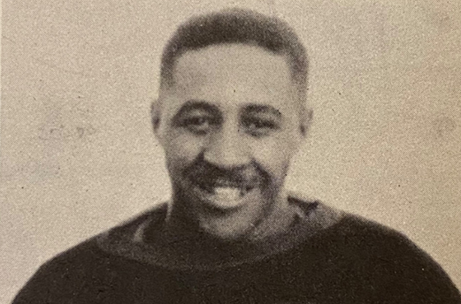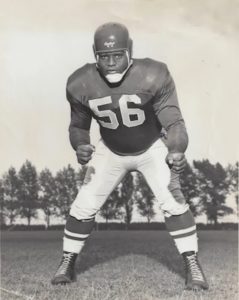Welcome to the Varsity Stadium stop of the Black History Here & Now Virtual Tour, where we will learn about Black Canadians in football.

While closely related to the American version of the game, Canadian football claims distinct history, traditions and organization, evolving in Canada from early versions of rugby and soccer.
Records indicate that the first game was played at University College at the University of Toronto in 1861. The University of Toronto's connection to the sport's development is evidenced through Varsity Stadium, which hosted the Grey Cup as early as November 25, 1911, and would go on to host 30 Grey Cup championships between 1911 and 1957.

during the 1954 Grey Cup, Montreal
vs Edmonton. Photo: U of T Archives
Despite systemic barriers and discrimination, Black athletes demonstrated remarkable resilience and achievement throughout the complex history of North American football. Black players initially excelled in these leagues before barriers to participation were imposed. From 1933 to 1946, the National Football League (NFL) enforced a ban on Black athletes excluding them from professional football. While research shows no evidence of an official policy against Black players in Canada, a similar gap in participation occurred during this period.
During this period of segregation in America, Canadian football teams implemented a policy allowing each team to sign five American players, which created a pathway for Black American athletes to pursue professional football careers in Canada. By 1967, Black athletes held 35% of the spots allocated to American players in the CFL. Canadian football also became a space in the 1970s and 1980s where Black quarterbacks could establish themselves at time when systemic racism in American football denied them access to the quarterback position.

Despite the greater representation and a narrative that Canada was more racially tolerant than America, Black athletes’ experiences were not absent of discrimination and oppression. Racism was present in their daily lives as even top Black players experienced barriers renting apartments, finding work, and faced racial hostility from teammates. However, Black football players did not passively accept these conditions but rather used their status to actively, challenge racism, the normativity of Whiteness, and fight for social change, speaking out against discrimination and oppression.
Read more about the contributions of Black athletes to the sport of football below.
Athlete Spotlight
russell gideon

Russell Gideon, born in 1904 in Liverpool, Nova Scotia, made history as the first Black player in Canadian senior football, playing for the Calgary Tigers from 1925 to 1933. A gifted multi-sport athlete, he excelled in hockey, baseball, track, and football. He was often was named the star of the game in the football league while also serving as president of the Victoria Park rotary athletics clubs during his time in Calgary. In 1933, Gideon left football to pursue education at Western Massachusetts School of Pharmacy, becoming one of its first Black graduates in 1941. After moving to Seattle in 1946, he established and operated a successful drugstore until 1963 while building an impressive legacy of community leadership. His influence extended from local organizations like the Seattle Urban League and Mount Zion Baptist Church to national prominence as Sovereign Grand Commander of the Prince Hall Freemasons' Northern Jurisdiction. From 1977 until his death in 1985, Ebony magazine consistently recognized him as one of America's 100 most influential Black citizens.
Learn more about Russell Gideon
Robert Ellis jackson

In 1930 Robert Ellis "Stonewall" Jackson joined the Regina Roughriders as the second Black professional player in Canadian football. During his tenure on the Roughriders, Jackson maintained a day job as porter on the Canadian National Railway Company. In fact, it is noted that Jackson worked on the trip from Regina to Toronto before playing in the Grey Cup in 1930, working on the trip back home. Similar to Russell Gideon’s experiences, the local media identified Jackson by the colour of his skin before his playing ability. Jackson would not rejoin the team in 1931 and there are no records of Jackson playing football anywhere else. With the “unofficial” racial segregation observed in the NFL from 1933 to 1946, there was not to be another Black player in Canadian professional football until Herb Trawick in 1946.
Learn more about Robert Jackson
Herb Trawick

Photo: African American Registry
Herb Trawick, born in Pittsburgh, Pennsylvania, was the first Black American player in the official CFL when he joined the Montreal Alouettes in 1946. Playing both offensive lineman and defensive guard, he spent twelve seasons with the Alouettes, appearing in four Grey Cups. His excellence earned him seven CFL East All-Star selections. A fan favorite and respected leader, Trawick served as team captain in 1951 and even competed as a professional wrestler during his playing career. He retired at age 32, and in 1975 was inducted into the Canadian Football Hall of Fame, where his coach Lew Hayman praised him as the best two-way player he had ever coached. After football, Trawick stayed in Montreal as the owner of Ace Distributing Company, while also scouting for the NFL's Denver Broncos.
Additional Resources
Learn more about Lorne King, a Varsity Blues athlete who was the first Black player from a Canadian University to be selected in the 1992 CFL Draft.
Sources
3DownNation: Uncovering the Black football trailblazers Canada forgot
Montreal Alouettes: Herb Trawick, the man who broke the CFL's colour barrier
The Canadian Football Research Society Flying Wing, Vol 2 No 2 (PDF)
HistoryLink.org: Russell Gideon
The Montreal Gazette (via Google Books): May 6, 1971- Trawick Raps Values; November 6, 1954: Last Year with Alouettes Says Herb Trawick But Nine Year Veteran Going Strong
Be sure to explore the other stops on the Black History Here & Now virtual tour to delve further into the experiences of Black Canadians in sport and physical activity.

